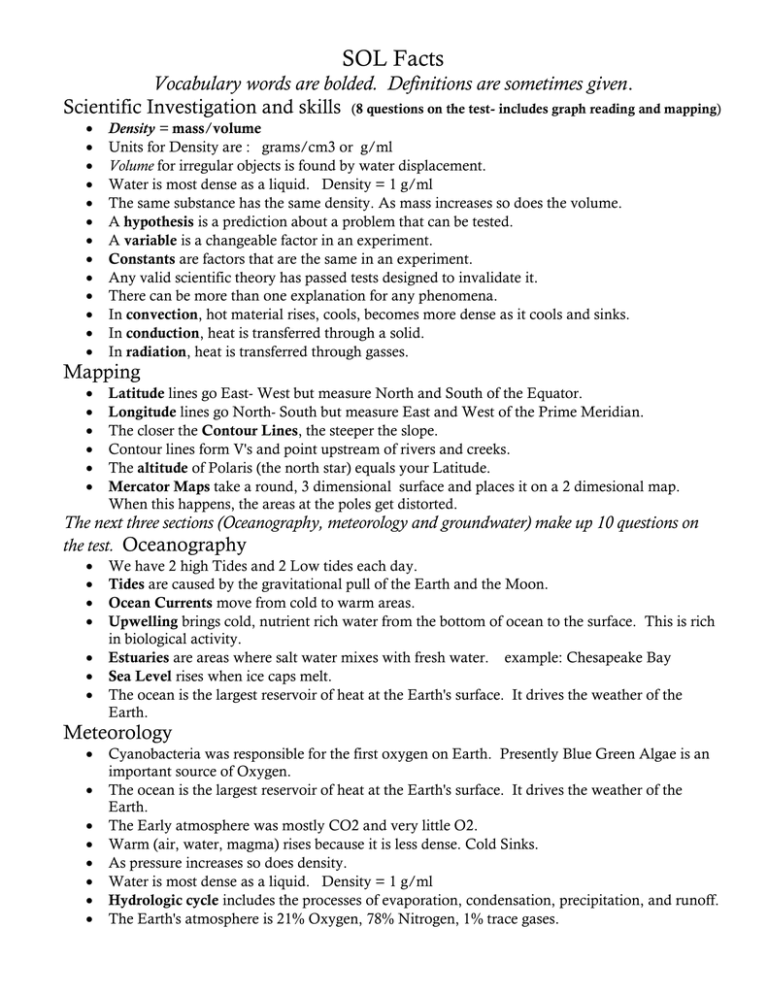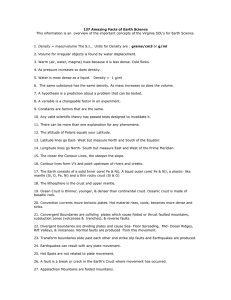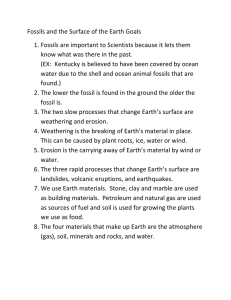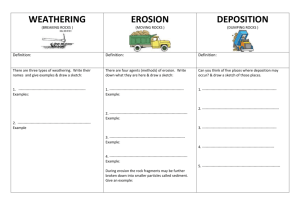SOL Facts Vocabulary words are bolded. Definitions are sometimes given
advertisement

SOL Facts Vocabulary words are bolded. Definitions are sometimes given. Scientific Investigation and skills (8 questions on the test- includes graph reading and mapping) Density = mass/volume Units for Density are : grams/cm3 or g/ml Volume for irregular objects is found by water displacement. Water is most dense as a liquid. Density = 1 g/ml The same substance has the same density. As mass increases so does the volume. A hypothesis is a prediction about a problem that can be tested. A variable is a changeable factor in an experiment. Constants are factors that are the same in an experiment. Any valid scientific theory has passed tests designed to invalidate it. There can be more than one explanation for any phenomena. In convection, hot material rises, cools, becomes more dense as it cools and sinks. In conduction, heat is transferred through a solid. In radiation, heat is transferred through gasses. Mapping Latitude lines go East- West but measure North and South of the Equator. Longitude lines go North- South but measure East and West of the Prime Meridian. The closer the Contour Lines, the steeper the slope. Contour lines form V's and point upstream of rivers and creeks. The altitude of Polaris (the north star) equals your Latitude. Mercator Maps take a round, 3 dimensional surface and places it on a 2 dimesional map. When this happens, the areas at the poles get distorted. The next three sections (Oceanography, meteorology and groundwater) make up 10 questions on the test. Oceanography We have 2 high Tides and 2 Low tides each day. Tides are caused by the gravitational pull of the Earth and the Moon. Ocean Currents move from cold to warm areas. Upwelling brings cold, nutrient rich water from the bottom of ocean to the surface. This is rich in biological activity. Estuaries are areas where salt water mixes with fresh water. example: Chesapeake Bay Sea Level rises when ice caps melt. The ocean is the largest reservoir of heat at the Earth's surface. It drives the weather of the Earth. Meteorology Cyanobacteria was responsible for the first oxygen on Earth. Presently Blue Green Algae is an important source of Oxygen. The ocean is the largest reservoir of heat at the Earth's surface. It drives the weather of the Earth. The Early atmosphere was mostly CO2 and very little O2. Warm (air, water, magma) rises because it is less dense. Cold Sinks. As pressure increases so does density. Water is most dense as a liquid. Density = 1 g/ml Hydrologic cycle includes the processes of evaporation, condensation, precipitation, and runoff. The Earth's atmosphere is 21% Oxygen, 78% Nitrogen, 1% trace gases. Meteorology (cont’d) The layers of the atmosphere are, from bottom up are : troposphere (where we live and where the weather is), Stratosphere (Ozone layer), Mesosphere, and Thermosphere. Human activities such as burning fossil fuels has increased CO2 levels. High CO2 levels produce the Greenhouse effect. CFC's are decreasing the ozone levels of the upper atmosphere Areas near the Equator receive the most direct radiation. Clouds form when air is at or below its dew point and condensation nuclei are present. Coriolis Effect causes deflections of the atmosphere & oceans due to rotation of Earth. A psychrometer measures humidity in the air. A barometer measures air pressure. High Pressure Systems are cool and dry with sinking air at the center: Low Pressure Systems are warm and wet with air rising at the center. Wind is due to unequal cooling that causes air pressure differences. Wind blows from high to Low. Cold fronts move quickly and produce rain at the Front. Warm fronts move slow and produce miles and miles of clouds. The highest pressure is found at Sea level. High pressure moves clock-wise and outward. Low pressure moves Counter- Clockwise and inward. U.S. weather is dominated by Prevailing Westerlies. Weather moves west to east. The Earth is closer to the sun in the winter. Ground Water Ground water layers from the surface down would include zone of aeration, water table, & zone of saturation. An Aquifer is a layer of rock that transports groundwater freely. A spring is an area where the water table reaches the land's surface. The Earth's Water Supply is renewable but also finite. Less than 1% of all water on earth is drinkable, most water exists in our oceans Astronomy (8 questions on the test) The altitude of Polaris (the north star) equals your Latitude. The Earth is about 4.6 billion years old. Summer Solstice is June 21st( longest day). Winter Solstice is December 21st( shortest day). Solstice is when the sun is at its most Northern or Southern Point. Equinoxes occur when the sun is directly over the equator. Spring (Vernal Equinox) March 21st and Fall (Autumnal Equinox) September 22nd.( 12 hours of daylight and 12 hours of night) The Earth is closer to the sun in the winter. The Earth rotates W to E once in 24 hours. The Earth revolves Counter-Clockwise around the sun once in 365.25 days. The Earth is the 3rd planet from the sun. The moon has phases because of reflected sunlight and the angle at which we view it. The Coriolis Effect (or Coriolis Force) prove the Earth rotates. Parallax and Seasonal constellations prove the Earth's revolution. Two types of planets—Inner/Terrestrial (rocky) and Outer/Jovian/Gas Giants (gaseous) Comets are known as dirty snowballs in space and originate in the Oort cloud. Comet's tail is the result of the Solar Wind and points away from the sun. Comet's coma is the result of the sun's radiation. Astronomy (cont’d) Asteroids are rocky or metallic iron objects with origins between Mars and Jupiter. 1 AU= distance of Earth and Sun. We measure planet distances in AU's. A Light Year is the distance light travels in a year. We measure star and galaxy distances with Light years. Apollo 11 was the 1st manned landing on the moon. Neil Armstrong was the 1st man on the moon. The Big- Bang explains the origin of the Universe. The Universe began as a dense sphere that expanded and condensed into galaxies. The Solar Nebulae Theory explains that the planets formed from the condensing of our sun or solar nebulae. Our Sun's Life cycle is Nebulae, protostar, Yellow Main Sequence Star, Red Giant, White dwarf and black dwarf. Black holes are a death stage of SUPER MASSIVE stars. We are located in the Milky Way Galaxy which is a spiral galaxy. The 3 types of Galaxies are spiral, elliptical, and irregular. The Hubble Space telescope has improved our knowledge and understanding of the Universe. Red Shift of galaxies indicate that galaxies are moving away from each other; therefore, the universe is expanding outward. This is used to support the Big Bang Theory. Geology (24 questions on the test) Earth Structure The Earth consists of a solid Inner core( Fe & Ni), A liquid outer core( Fe & Ni), a plastic- like mantle (Si, O, Fe, Ni) and a thin rocky crust (Si & O) The lithosphere is the crust and upper mantle. This is where the plates are. Ocean Crust is thinner, younger, & denser than continental crust. Oceanic crust is made of basaltic rock. Continental Crust is made of Granite. Plate Tectonics An Ocean plate will always sink under a continental plate because it is more dense. Convection currents move tectonic plates (in the asthenosphere). Convergent Boundaries are colliding plates which cause folded or thrust faulted mountains, subduction zones (volcanoes & trenches), & reverse faults. Divergent boundaries are dividing plates and cause Sea- Floor Spreading, Mid- Ocean Ridges, Rift Valleys, & Volcanoes. Normal faults are produced from this movement. Transform boundaries slide past each other and strike slip faults and Earthquakes are produced. Earthquakes can result with any plate movement. Hot Spots are not related to plate movement. A fault is a break or crack in the Earth's Crust where movement has occurred. Appalachian Mountains are folded mountains. Volcanic activity is associated with subduction, rifting, or sea floor spreading. 3 seismic stations are needed to find the epicenter of an Earthquake. P waves travel the fastest and reach the Seismic station first. P waves travel through solids and liquids. P waves slow down and bend when they hit the liquid outer core. S waves do not travel through liquids. Weathering, Erosion and Deposition Weathering is the process that rocks are broken down by water, air, and organisms. Chemical Weathering occurs in warm, humid climates. Mechanical Weathering occurs in cold climates--- Ice Wedging. Weathering, Erosion and Deposition (cont’d) Erosion is the process by which Earth materials are transported by moving water, ice, or wind. Gravity causes all these to happen. Streams and moving water are the major agents of Erosion. Deposition is the dropping or settling out of sediment. High Erosion = high relief areas High deposition = low relief areas Large particles settle out first. Sediment size from largest to smallest- Breccia, Sand, silt, clay. As particle size increases, permeability ( the ability to transport water) increases. Soil Evolution starts with the weathering of bedrock. Organic material must be present in order to have Soil. Soil profile consists of 3 horizons: A- Top Soil( most evolved) B- less humus, leaching from A C- Weathered Rock Karst Topography has caves and sinkholes produced by acidic groundwater dissolving limestone. Valley and Ridge Province is famous for Karst topography. VA Geology The Coastal plain is the flattest area underlain by all types of sediments produced by the erosion of the Appalachian mountains. Fossils are abundant here. Piedmont is underlain by igneous and metamorphic rocks produced by ancient volcanoes. Separated by a fall line from the Coastal plain. Blue- Ridge- oldest in the State Valley and Ridge- long parallel ridges composed of folded and faulted rocks that occurred during the collision of Africa and North America during the Paleozoic. Karst Topography & fossils are abundant. Appalachian underlain by sedimentary rocks. Coal resources are found here. Fossils present. Rocks and Minerals A mineral is found in nature, inorganic, solid, with a definite chemical composition and structure. Mineral properties depend on their atomic structure and include: streak, hardness, luster, crystal shape, texture, taste, smell, specific gravity, cleavage and fracture. Ores are useful and profitable. Igneous rocks are classified by composition and texture. Igneous Rocks are produced by the cooling of magma or lava. Fast cooling magma= Extrusive igneous rocks - Texture includes small mineral grains, glassy, air holes present. ( Pumice, Basalt, Obsidian) Slow cooling magma= Intrusive igneous rock- Texture includes coarse or large mineral grains.( Granite) Metamorphic formed by heat and pressure. Metamorphic include foliated ( banded) and non foliated. Foliated Metamorphic rocks rocks are slate, schist, gneiss. Non foliated include marble and quartzite. Limestone morphs into marble. Sandstone morphs into quartzite. Sedimentary rocks form from rock fragments, organic material, or chemical precipitation. Sedimentary are found in flat layers or strata. Fossils are found in these layers. Sedimentary subclasses include clastic, organic, and chemical. Limestone is formed both chemically and organically. Clastic rocks are made of fragments- Conglomerate, sandstone, and shale. Natural Resources Virginia resources include limestone, coal, and gravel. Renewable resources can be replaced by nature at a rate close to the rate at which they are used. Includes vegetation, water, and soil. Nonrenewable Resources are renewed very slowly or not at all. Includes coal, oil, and minerals. The Earth's Water Supply is renewable but also finite. Coal Evolution from softest to hardest- Peat, Lignite, Bituminous, Anthracite Relative and Radiometric Dating A fossil is the remains, impressions, or other evidence of a former existence of life preserved in rock. Virginia's fossils are mostly marine and are from all Era's in history. Law of Superposition states that the oldest rocks are found on the bottom of strata and the youngest on top of strata. Law of Cross-cutting relationships states that an igneous intrusion is younger than the layers it cuts across. Fossils, Superposition, and Cross-cutting are used to determine relative ages. Relative ages are placing events in sequence without assigning exact numerical ages. Absolute time places a numerical age to an event. Radioactive decay or half-life is used to determine the absolute age of rocks. Uranium dating is used to find the ages of the oldest rocks. Carbon-14 is used to find the ages of human artifacts. The Earth is about 4.6 billion years old. Unconformities are missing rock layers usually a result of erosion.





